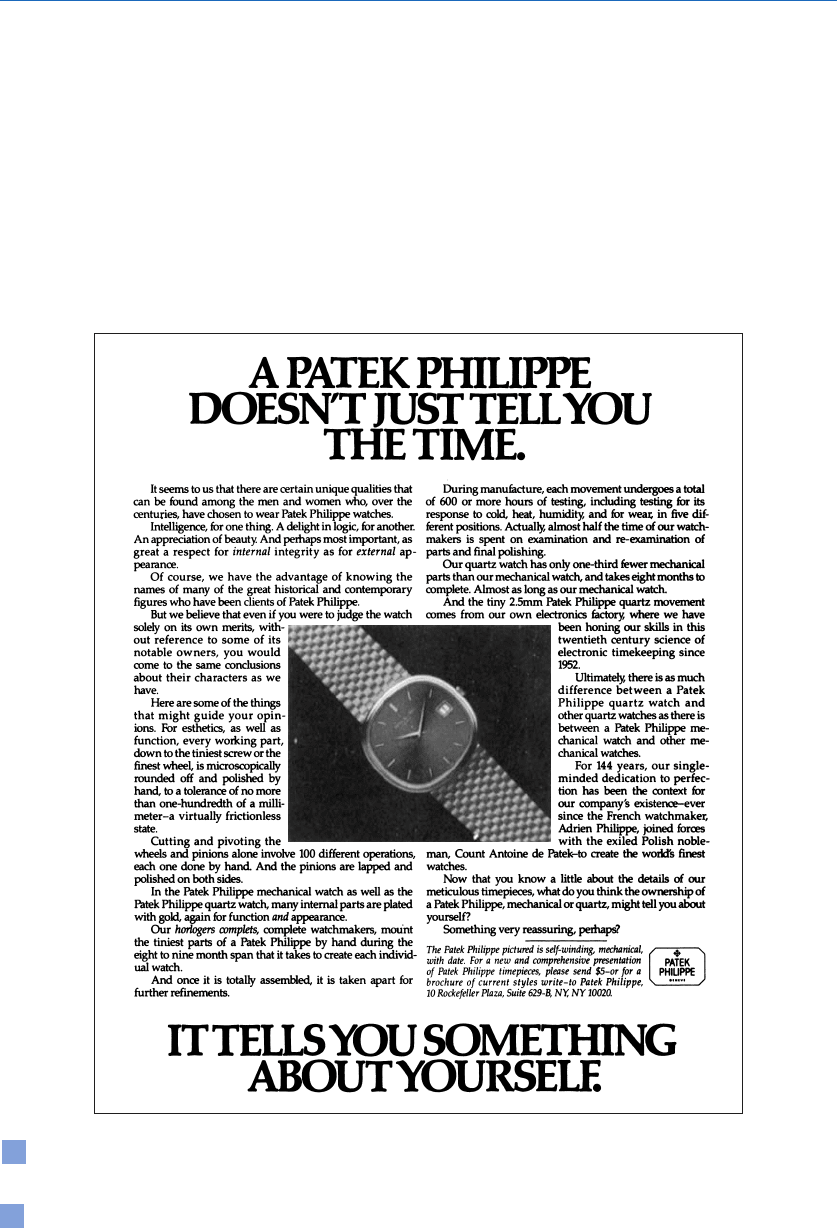Onkvisit S., Shaw J. International Marketing: Analysis and Strategy
Подождите немного. Документ загружается.


affected by the profit motive as well as by market
conditions. In any case, the export merchant hopes
that the price at which the product is sold will
exceed all costs and expenses in order to provide a
profit. An export merchant may sometimes seek
extra income by importing goods to complement its
export activities. The merchant may or may not
offer a steady business relationship to his supplier.
Export drop shipper
An export drop shipper, also known as a desk jobber
or cable merchant, is a special kind of export
merchant. As all these names imply, the mode of
operation requires the drop shipper to request a
manufacture to “drop ship” a product directly to the
overseas customer. It is neither practical nor desir-
able for the shipper to physically handle or possess
the product. Based on this operational method, the
shipper’s ownership of the goods may last for only
a few hours.
Upon receipt of an order from overseas, the
export drop shipper in turn places an order with a
manufacturer, directing the manufacturer to deliver
the product directly to the foreign buyer.The man-
ufacturer collects payment from the drop shipper,
who in turn is paid by the foreign buyer.
Use of a drop shipper is common in the inter-
national marketing of bulky products of low unit
value (e.g., coal, lumber, construction materials).
The high freight volume relative to the low unit
value makes it prohibitively expensive to handle
such products physically several times. Minimizing
physical handling reduces the cost accordingly.
One may question why a manufacturer does not
simply deal directly with a foreign buyer, bypassing
the drop shipper and saving money in the process –
the shipping instructions would reveal the name and
address of the foreign buyer.The answer is that the
manufacturer can reduce the risk while simplifying
the transactional tasks. It is a great deal easier for
the manufacturer to call the export drop shipper
in the manufacturer’s own country instead of trying
to sell to and collect from the buyer in a far-away
destination.
There are also good reasons why the foreign
buyer may not be able to or want to bypass the
export drop shipper. The buyer may not have ade-
quate product knowledge or supply knowledge, and
the buyer’s order may be too small to entice the
manufacturer to deal directly. The drop shipper is
thus valuable because this kind of merchant is highly
specialized in knowing the sources of supply and
markets. The drop shipper also has information
and advice about the needed product and can
arrange all details for obtaining it.
Export distributor
Whereas export merchants and drop shippers pur-
chase from a manufacturer whenever they receive
orders from overseas, an export distributor deals
with the manufacturer on a continuous basis. This
distributor is authorized and granted an exclusive
right to represent the manufacturer and to sell in
some or all foreign markets. It pays for goods in its
domestic transaction with the manufacturer and
handles all financial risks in foreign trade.
An export distributor differs from a foreign dis-
tributor simply in location.The foreign distributor
is located in a particular foreign country and is
authorized to distribute and sell the product there.
The export distributor, in comparison, is located in
the manufacturer’s country and is authorized to sell
in one or more markets abroad. Consider Mamiya,
a Japanese manufacturer. J. Osawa is Mamiya’s
worldwide distributor (i.e., export distributor).
Bell and Howell: Mamiya is in turn J. Osawa’s exclu-
sive US distributor (i.e., foreign distributor).
The export distributor operates in its own name
or in that of the manufacturer. It handles all ship-
ping details, thus relieving the manufacturer of
having to pay attention to overseas activities. In
other words, the sale made to the export distribu-
tor is just like another domestic transaction for the
manufacturer. Because the export distributor, as a
rule, represents several manufacturing firms, it is
sometimes regarded as a form of EMC.
The export distributor usually sells the manu-
facturer’s product abroad at the manufacturer’s list
356
CHANNELS OF DISTRIBUTION

price and receives an agreed percentage of the list
price as remuneration; that is, the export distribu-
tor is either paid by commission or allowed a dis-
count for its purchase.The manufacturer may bill a
foreign buyer directly or may let the distributor bill
the buyer to obtain the desired margin.
Trading company
Those that want to sell and those that want to buy
often have no knowledge of each other or no know-
ledge of how to contact each other. Trading com-
panies thus fill this void. In international marketing
activities for many countries, this type of interme-
diary may be the most dominant form in volume of
business and in influence. Many trading companies
are large and have branches wherever they do busi-
ness. They operate in developing countries, devel-
oped countries, and their own home markets.
Half of Taiwan’s exports are controlled by trading
companies. In Japan, general trading houses are
known as sogo shosha, and the largest traders include
such well-known MNCs as Mitsubishi, Mitsui, and
C. Itoh.The nine largest trading firms handle about
half of Japan’s imports and exports. Even large
Japanese domestic companies buy through trading
companies.
A trading company performs many functions:the
term describes many intermediaries that are neither
brokers nor import merchants. A trading company
may buy and sell as a merchant. It may handle goods
on consignment, or it may act as a commission
house for some buyers. By representing several
clients, it resembles an EMC, except for the fact that
it (1) has more diverse product lines, (2) offers
more services, (3) is larger and better financed, (4)
takes title (ownership) to merchandise, (5) is not
exclusively restricted to engaging in export trade,
and (6) goes beyond the role of an intermediary
(which provides only export facilitation services) by
engaging directly in production, physical distribu-
tion channel development, financing, and resource
development.
As the name implies, the trading company trades
on its own account for profit. By frequently taking
title to the goods it handles, its risks of doing busi-
ness greatly increase. A trading company does not
merely represent manufacturers and/or buyers,
thus reducing risks, because increased risks are
usually accompanied by increased rewards. In the
case of WSJ International, which is a trader as well
as a representative, profit margins gained on trading
are about four times greater than margins on rep-
resentative sales. It is thus not surprising that trading
accounts for half of the company’s revenues.
Manufacturers and buyers use trading companies
for good reasons.The trading company gathers mar-
ket information;does market planning, finds buyers;
packages and warehouses merchandise; arranges and
prepares documents for transportation, insurance,
and customs; provides financing for suppliers
and/or buyers; accepts business risks; and serves
foreign customers after sales. It is, in short, a valu-
able entity in overcoming cultural and institutional
barriers. Nanodata, for example, concluded that it
was too expensive to reach unfamiliar and distant
market areas. The company hired TKB Technology
Trading Corporation, a trading company, to identify
good European markets for Nanodata’s computer
and to develop a distribution channel by choosing
agents, distributors, or direct subsidiaries. TKB
offered entry without expensive staff buildup until
Nanodata was ready to do so on its own.
Like other intermediaries, however, the trading
company must always face the possibility of being
bypassed by its clients, and it thus must offer some-
thing of value to its customers.This holds true even
for Mitsubishi, the world’s largest trader with more
than $164 billion in sales.Without its own produc-
tion, this company could be squeezed out by
Japanese clients that would set up their own mar-
keting departments. Mitsubishi’s solution in keeping
old customers and getting new ones is to give
buyers and sellers an incentive to do business with
it. It has formed joint ventures with American and
Japanese partners with an aim to acquire ownership
influence with both its suppliers and customers.
Furthermore, this firm cannot be easily replaced
because of its long experience, expertise, and estab-
lished networks.
1111
2
3
4
5
6
7
8
9
10111
1
2
3
4
5
6
7
8
9
20111
1
2
3
4
5
6
7
8
9
30
1
2
3
4
5
6
7
8
9
40
41
42
43
44
45111
357
CHANNELS OF DISTRIBUTION

Japanese trading companies
Because of the spectacular success of the huge
Japanese trading companies, many companies –
especially those in the USA – would like to emulate
or duplicate them. Japanese trading companies per-
form a number of marketing functions:market iden-
tification and analysis, sales forecasts, buying goods
from manufacturers, selling goods to customers,
and bearing financial risks (see Figure 12.4).
Japanese trading companies have several distinct
characteristics. They are supported by domestic
Japanese business.They are partners with groups of
banks and other financial intermediaries, allowing
them easy, convenient,and almost permanent access
to enormous amounts of capital and financing.
Traditionally, Japanese manufacturers prefer to
separate manufacturing from marketing, leaving the
marketing function to trading firms.A new breed of
Japanese manufacturers, however, prefers to have
more marketing control and has been shifting away
from this pattern of specialization by pursuing
forward integration. Responding to this adverse
358
CHANNELS OF DISTRIBUTION
Figure 12.4
Japanese trading company
Source:
Reprinted with permission
of Marubeni America Corporation.

trend, the sogo shosha is emphasizing its core com-
petence: information gathering. It has transformed
itself into an information-based organization.
Export trading companies
In the USA, the Export Trading Company (ETC) Act
was passed in 1982.Title III of the 1982 Act allows
domestic competitors to obtain binding antitrust
preclearance for specified export activities. By
granting prior antitrust immunity, the antitrust
threat was removed, creating a favorable environ-
ment for the formation of joint export ventures.
The firms that have recently formed ETCs are
from various backgrounds. Some are manufacturers
with subsidiaries that have ready access to the
parents’ products. GE Trading Company, for
example, has access to GE’s 300,000 products.
Retailers such as Sears and Kmart have a great deal
of bargaining power because of their enormous pur-
chases, and this leverage serves them well in mar-
keting US exports through foreign retail chains.
Other organizations forming ETCs are banks, which
seem natural for this purpose. Because banks can
own up to 100 percent of an ETC’s stock, these
ETCs are guaranteed to have adequate financial
resources. In some cases, banks and other business
firms may want to form a joint venture, as in the
case of First Chicago and Sears World Trade, Inc.
One problem with ETCs is that the ETC Act is
designed to promote only US exports.Thus ETCs’
import activities must take a secondary position,
undertaken only when they are needed to promote
exports. Consequently, ETCs may lack an efficient
infrastructure for developing two-way trade. In this
regard, ETCs differ greatly from Japanese trading
companies, which achieve their efficiencies through
domestic, foreign, and third-country trading activi-
ties.American ETCs may thus lack a comprehensive
international perspective.
CHANNEL DEVELOPMENT
The suitability of a particular channel depends
greatly upon the country in which it is used. A par-
ticular type of intermediary that works well in one
country may not work well elsewhere or may lose
effectiveness over time. This does not necessarily
mean that each country requires a unique channel.
However, a company may find that a country classifi-
cation system is useful, a system that can be used to
determine how the distribution strategy should be
set up from one group of countries to another.
Litvak and Banting suggest the use of a country
temperature gradient to classify countries.
6
Their
classification system is based on the following
environmental characteristics: (1) political stability,
(2) market opportunity, (3) economic development
and performance, (4) cultural unity, (5) legal barri-
ers/restrictions, (6) physiographic barriers, and (7)
geocultural distance. Based on these characteristics,
countries may be classified as hot, moderate, or
cold. A hot country is one that scores high on the
first four characteristics and low on the last three.
A cold country is exactly the opposite, and a mod-
erate one is medium on all seven characteristics.
The USA generally falls in line with the charac-
teristics of a hot country. So does Canada, even
though its cultural unity is moderate (rather than
high) and its physiographic barriers are moderate
(rather than low). Germany, likewise, is a hot
country in spite of some slight interference in the
sense that its legal barriers and geocultural distance
are moderate rather than low. Brazil, in contrast,
largely conforms to a cold country’s characteristics.
It is a judgment call whether so many character-
istics are necessary for the purpose of classifying
countries.The level of economic development could
be used as the sole indicator, but such a classification
would be misleading because hot countries are not
the same as industrialized countries. However, one
mustquestionwhetherrefinement and improvement
in the classification process justifies the extra effort
necessary to wade through all relevant characteris-
tics, especially since the level of economic develop-
ment correlates well with these characteristics. For
practicality, a short-cut appears to be desirable.
Classification is a means to an end, and the
purpose of the country temperature gradient is to
determine which intermediary should be used in a
1111
2
3
4
5
6
7
8
9
10111
1
2
3
4
5
6
7
8
9
20111
1
2
3
4
5
6
7
8
9
30
1
2
3
4
5
6
7
8
9
40
41
42
43
44
45111
359
CHANNELS OF DISTRIBUTION

given country. The temperature gradient also indi-
cates which kind of intermediary is likely to be func-
tioning in a country. In a cold country, competitive
pressures on institutional change are not dynamic.
Legal restrictions, for example, can prevent or
slow down new distribution innovations. Consider
Egypt as an example.Only persons born of Egyptian
fathers or Egyptian legal entities can represent
foreign principals. Being “comfortably cold,” mid-
dlemen see few threats to their existence. In China,
all tobacco must be sold through the China National
Tobacco Co. monopoly.
For a hot country, environmental forces may be
so hot that new institutional structures arise.
Middlemen who fail to adjust will be bypassed and
go out of existence. The survival of a channel
member is thus a function of the ability to adapt to
changing environmental conditions because the
channel member cannot hide behind local regula-
tions for protection. For example, in the United
Kingdom, either the principal or the intermediary
can terminate an agency relationship provided
reasonable notice is given.
The country temperature gradient has implica-
tions for all channel members. A foreign manufac-
turer can exercise maximum control over the
evolutionary process in the distribution channel.
The firm can rely initially on middlemen/distribu-
tors. If sales increase, the manufacturer can bypass
the intermediary by setting up a sales branch or sub-
sidiary. This is the trend being followed by foreign
liquor suppliers in the US market. These suppliers
now very much control their own destiny by being
responsible for their own distribution. E. Remy
Martin & Co. took its cognac away from Glenmore
Distillers and became its own US distributor
through its Premier Wine Merchants. Distillers Co.,
a Scottish firm, acted likewise by buying Somerset
Importers from Esmark. Pernod Ricard and Monet-
Hennessy adopted the same strategy by buying
Austin Nichols and Schieffelin, respectively.
A local manufacturer should be alert to any new
channel since the new channel may pose a threat to
this existing channel. When possible, the manufac-
turer must pre-empt the competition from using it.
Xerox was successful and secure with its direct sales
force channel – so secure that, when the Japanese
competition entered the market, Xerox was totally
unprepared. The Japanese invaded the US market
quickly and cheaply by using independent office
equipment dealers, a channel that had been ignored
by Xerox.The Japanese firms had their own direct
sales force in large metropolitan areas, but they also
supplied their machines to such US firms as IBM,
Monroe, and Pitney Bowes, thus exploiting these
US firms’ extensive sales and distribution networks.
Xerox was forced to experiment with such alterna-
tive channels as retail stores, direct mail, and part-
time representatives.
Wholesalers, especially those involved in high-
margin, low-volume operations, are particularly
vulnerable to the threat posed by modern institu-
tions.Wholesalers can easily be bypassed if they are
successful in promoting their principals’ products.
Superscope, for example, lost the Sony franchise.
On the other hand, if wholesalers do the job poorly,
they are also likely to be eliminated or their author-
ity and responsibility reduced. Mitsubishi was so
unhappy with Chrysler’s performance that the
Japanese company developed its own independent
dealer network in order to catch up with Toyota and
Nissan.
Innovations tend to take place in a hot country
before spreading to other hot countries and finally
developing countries. Retailing innovations that
conform to this description include self-service
stores, discount houses, and supermarkets, all of
which developed initially in the USA.Hypermarche,
on the other hand, is a mass-merchandising method
developed in Europe. This retail store is an enor-
mous self-service combination of foods and general
merchandise, generally displayed in shipping con-
tainers. A single set of checkout counters is used.
This innovation has had only limited success when
introduced in the USA.
The success of an innovation is affected not only
by the country temperature gradient but also by
several other factors. A certain minimum level of
economic development is required to support any
form of outlet beyond simple retailing methods.
360
CHANNELS OF DISTRIBUTION

General stores, a dying breed in the USA, are still
very common in many countries. Firms’ aggressive
behavior will also be a determinant of the success
of a new retailing method. Other cultural, legal, and
competitive factors play an important role too. In
developing countries, where there is plenty of low-
cost labor and where people are accustomed to
being waited on, self-service stores, discount
houses, and supermarkets are slow in gaining wide-
spread acceptance. In developed countries, by
comparison, various factors work in favor of large
modern discount stores/supermarkets, including
high population density, urbanization, literacy, and
labor costs. In addition, the high income level and
relatively even income distribution make refrigera-
tors and automobiles affordable and accommodate
infrequent shopping trips and large purchases.
CHANNEL ADAPTATION
Because the standardized approach to international
marketing strategy may not apply to distribution
strategy in foreign markets, it is imperative that
international marketers understand the distribution
structures and patterns in those markets. Toward
this end, comparative marketing analysis should
be conducted. Distribution is likely to be highly
adapted to the different conditions in Africa, Latin
America, and Asia.These regions’ government reg-
ulations as well as local customs act as a barrier to
distribution standardization.
Some channel adaptation is frequently a neces-
sity. Suspicion and privacy can limit the effective-
ness of door-to-door selling or other direct selling
methods.Avon has had to develop other distribution
methods in Japan and Thailand. Discount retailing
may not be effective in countries where there are
many middlemen handling small volumes of mer-
chandise. A traditional distribution channel may
seem inefficient, but it may maximize the use of
inexpensive labor, leaving no idle resources.
A manufacturer must keep in mind that, due to
adaptation, a particular type of retailer may not
operate in exactly the same manner in all countries.
Whereas a US supermarket emphasized a low gross
margin, its foreign counterpart may have a relatively
high gross margin, emphasizing specialty goods and
imported goods to a high degree. Furthermore, the
foreign counterpart often operates a ready-to-eat
food section. Interestingly,American supermarkets,
especially those that have been converted into
superstores, have begun to do the same.
A particular distribution concept proven useful
in one country may have to be further refined in
another. Although 7–11 pioneered the convenience
food store concept in Japan, the Japanese operation
has evolved into being more sophisticated than its
original counterpart in the USA. 7–11 Japan offers
its customers steaming fish cakes, canned tea, and
rice balls, while accepting payment for utility bills
and accepting orders from Tiffany’s catalog. To
provide the most popular and latest products, about
two-thirds of a typical store’s 3000 items will
change in a year.
CHANNEL DECISIONS
As in any domestic market, the international market
requires a marketer to make at least three channel
decisions: length, width, and number of channels of
distribution. Channel length is concerned with
the number of times a product changes hands among
intermediaries before it reaches the final consumer.
The channel is considered long when a manufac-
turer is required to move its product through
several middlemen.The channel is considered short
when the product has to change hands only one or
twice. If the manufacturer elects to sell directly to
final consumers, the channel is direct.
Channel width is related to the number of
middlemen at a particular point or step in the dis-
tribution channel. Channel width is a function of
the number of wholesalers and the different kinds
that are used, as well as a function of the number
and kind of retailers used. As more intermediaries
or more types are used at a certain point in the
channel, the channel becomes wider and more
intensive. If only a few qualified intermediaries are
needed to provide proper product support at a
particular level or at a specific location, the channel
1111
2
3
4
5
6
7
8
9
10111
1
2
3
4
5
6
7
8
9
20111
1
2
3
4
5
6
7
8
9
30
1
2
3
4
5
6
7
8
9
40
41
42
43
44
45111
361
CHANNELS OF DISTRIBUTION

is selective. The product, though perhaps not avail-
able everywhere, is still carried by at least a few
qualified middlemen within the same area. Finally,
the distribution becomes exclusive if only one
intermediary of one type is used in that particular
area.
The watch industry and its distribution strategies
provides a good illustration of an industry with
various channel widths. Timex, as a low-priced,
mass-market product, is intensively distributed in
the sense that any intermediary, no matter what
kind, is allowed to carry the brand. Seiko is more
selective. Seiko, as an upper-medium-priced brand,
is sold through jewelry stores and catalog show-
rooms and is less likely to be found in discount or
drug stores. Patek Philippe, in order to promote an
image of elegance and exclusivity, limits its U.S.
outlets to 100 meticulously selected fine jewelry
stores. Figure 12.5 shows that Patek Philippe
chooses a channel that enhances an image.
362
CHANNELS OF DISTRIBUTION
Figure 12.5 Patek Philippe’s channel of distribution
Source:
Reprinted with permission of Henri Stern Watch Agency, Inc.

Channel width is relative. Both Seiko and Omega
employ selective distribution, though Omega is
much more selective. Omega’s tighter policy of
selective, limited distribution results in the brand
being available only in top jewelry, specialty, and
department stores. Due to the relative nature of
channel width, it is inappropriate to compare width
at the retail level with wholesale width. Because
there are many more retailers than wholesalers, the
issue of channel width applies only to a particular
distribution level rather than through distribution
levels.The degree of selectivity depends on the rela-
tive, not the absolute, number of intermediaries at
a particular distribution level. As a product moves
closer to end users, the distribution channel tends to
become broader. At a point closer to the manufac-
turer,the channel is not as broad.For example,at the
distributor level, Brother International is the exclu-
sive US distributor for Japan’s Brother Industries.
Another decision that concerns the manufacturer
is the number of distribution channels to be
used. In some circumstances, the manufacturer may
employ many channels to move its product to con-
sumers. For example, it may use a long channel and
a direct channel simultaneously. The use of dual
distribution is common if the manufacturer has
different brands intended for different kinds of con-
sumers.Another reason for using multiple channels
may involve the manufacturer setting up its own
direct sales force in a foreign market where the
manufacturer cannot remove the original channel
(e.g., agents) for strategic or legal reasons.Although
Seiko, Lassale, and Jean Lassale are all made by the
same Japanese firm, dual channels are used for these
brands. Seiko and Lassale are sold through distribu-
tors in the USA, whereas Jean Lassale is sold by the
manufacturer directly to retailers (jewelers).
DETERMINANTS OF CHANNEL TYPES
There is no single across-the-board solution for all
manufacturers’ channel decisions; yet there are
certain guidelines that can assist a manufacturer in
making a good decision. Factors that must be taken
into account include legal regulations, product
image, product characteristics, middlemen’s loyalty
and conflict, and local customs.
Legal regulations
A country may have specific laws that rule out the
use of particular channels or middlemen.France,for
example, prohibits the use of door-to-door selling.
Saudi Arabia requires every foreign company with
work there to have a local sponsor who receives
about 5 percent of any contract. Not surprisingly,
many Saudis, acting as agents, have become million-
aires almost overnight.
The overseas distribution channel often has to
be longer than desired. Because of government
regulations, a foreign company may find it necessary
to go through a local agent/distributor. In China,
foreign firms cannot wholly own retail outlets, and
they cannot engage in wholesaling activities. In
addition, only fourteen foreign retail ventures
have direct import authority, forcing those without
direct import authority to add another layer of mid-
dlemen. Foreign retailers are required to operate
through joint ventures, and they can own a maxi-
mum of 65 percent of such joint ventures. It is an
Asian tradition, however, to circumvent ownership
restrictions by having silent partners who have
nothing to do with daily operations.Carrefour S.A.,
for example, essentially wholly owned its three
northeastern supermarkets – until the government
cracked down on the practice.As a result,Carrefour
was forced to transfer 35 percent of the ownership
to two domestic trading firms.
7
Channel width may be affected by the law as well.
In general, exclusive representation may be viewed
as a restraint of trade, especially if the product has
a dominant market position. In Germany, the
Federal Cartel Office may intervene with exclusive
dealing and distribution requirements. Due to the
EU’s single market program, geographic barriers
between national markets have blurred, making it
possible for consumers outside national sales terri-
tories to gain greater access to products and
services. Therefore, EU antitrust authorities have
increased their scrutiny of “national” and exclusive
1111
2
3
4
5
6
7
8
9
10111
1
2
3
4
5
6
7
8
9
20111
1
2
3
4
5
6
7
8
9
30
1
2
3
4
5
6
7
8
9
40
41
42
43
44
45111
363
CHANNELS OF DISTRIBUTION

sales agreements.The Treaty of Rome prohibits dis-
tribution arrangements that affect trade or restrict
competition (i.e., restrictions on territory, non-
competition clauses, and grants of exclusivity). In
fact, in the case of automobiles, the Commission has
determined that exclusive distribution limited trade
between the member countries and that manufac-
turers thus had less incentive to price cars on a
competitive basis. It has directed the manufacturers
to allow distributors to sell to other dealers and
consumers throughout the EU.
Product image
The product image desired by a manufacturer can
dictate the manner in which the product is distrib-
uted. A product with a low-price image requires
intensive distribution. On the other hand, it is
not necessary nor even desirable for a prestigious
product to have wide distribution. Clinique’s prod-
ucts are sold in only sixty-four department stores in
Japan.Waterford Glass has always carefully nurtured
its posh image by limiting its distribution to top-
flight department and specialty stores.At one time,
it did not take on any retail accounts for a period of
a year. Its effort to create an air of exclusivity has
worked so well that Waterford Glass commands
a quarter of the US market, easily making it the
bestselling fine crystal.
Although intensive distribution may increase
sales in the short run, it is potentially harmful to the
product’s image in the long run. This is a problem
faced by Aprica as it moves its strollers beyond
department and specialty stores into mass-market
outlets such as JCPenney and Sears. Tiffany & Co.
lost many upper-class customers when it broadened
its clientele base. Cartier, in trying to restore its
esteem, has pared its retail distribution network,
which had proliferated unwisely, by 50 percent in
the USA and 25 percent worldwide.
Product characteristics
The type of product determines how the product
should be distributed. For low-priced, high-
turnover convenience products, the requirement is
for an intensive distribution network.The intensive
distribution of ice cream is an example. Walls’
(formerly Foremost’s) success in Thailand may be
attributed in part to its intensive distribution and
channel adaptation. Walls has tailored its distribu-
tion activities to the local Thai scene by sending its
products (ice cream, milk, and other dairy prod-
ucts) into the market in every conceivable manner.
Such traditional channels as wholesalers and such
new channels as company-owned retail outlets
(modern soda fountains) and pushcarts are also
used. Pushcarts are supplied by the company and
manned by independent retailers (i.e., sidewalk
salesman) who keep a 20 percent margin. However,
traditional channels employing wholesalers, small
stores, restaurants, hotels, and schools still account
for a majority of sales.
For high-unit-value, low-turnover specialty
goods, a manufacturer can shorten and narrow its
distribution channel. Consumers are likely to do
some comparison shopping and will more or less
actively seek information about all brands under
consideration. In such cases, limited product expo-
sure is not an impediment to market success.
One should always remember that products are
dynamic, and the specialty goods of today may
be nothing more than the shopping or even conve-
nience goods of tomorrow. Consider computers,
which were once an expensive specialty product
that required a direct and exclusive channel. Since
the early 1980s, computers have become more of a
shopping good, necessitating a longer and more
intensive channel. Now computers, like TV sets, are
sold in discount stores.
Middlemen’s loyalty and conflict
One ingredient for an effective channel is satisfied
channel members.As the channel widens and as the
number of channels increases, more direct compe-
tition among channel members is inevitable. Some
members will perceive major competing members
and self-service members as being unfair. Some
members will blame the manufacturer for being
364
CHANNELS OF DISTRIBUTION

motivated by greed when setting up a more inten-
sive network. In effect, intensive distribution
reduces channel members’ cooperation and loyalty
as well as increasing channel conflict. Michelin has
been accused of undercutting its own dealers in the
US market by not only expanding its dealer network
by 50 percent but also adding a direct channel to
take national accounts away from dealers. Both
actions increased price competition and reduced
dealers’ loyalty.Apple’s problems in Japan were due
in part to its addition of new channels, even though
it already had a major distributor.
One survey measured cooperative decisions
involving export managers from the USA and Peru,
during a sequence of three simulated interactions
with business partners. During the initial stage of
the relationship, decisions of Peruvian export man-
agers reflect less trust than do those of their
American counterparts. During the second stage,
Peruvian exporters respond differently to weak
cheating. Results generally are consistent with cul-
tural differences in attitudes toward in-group versus
out-group members. However, influence of cultural
differences gradually erodes in favor of personal
characteristics and relationship-specific history.
Therefore, cultural differences between business
partners decline in importance as they get to know
each other.
8
Local customs
Local business practices, whether outmoded or not,
can interfere with efficiency and productivity and
may force a manufacturer to employ a channel of
distribution that is longer and wider than desired.
Because of Japan’s multitiered distribution system,
which relies on numerous layers of middlemen,
companies often find it necessary to form a
joint venture with a Japanese firm, such as Pillsbury
with Snow Brand, Xerox with Fuji, and KFC with
Mitsubishi. Japan’s many-layered distribution
system is not entirely unique in that part of the
world, since the custom in many Far-Eastern coun-
tries is to have multiple intermediary markups on
imported goods. Yet the rule of thumb in Hong
Kong is that there should be no more than two
layers between a US exporter of finished goods and
Hong Kong consumers, usually consisting of an
importer, agent retailer, or distributor.
Domestic customs can explain why a particular
channel is in existence.Yet customs may change or
be overcome, especially if consumer tastes change.
For example, there are some 82,000 British pubs,
50,000 of which are owned by brewing companies;
the problem they face is the trend toward beer con-
sumption at home. The pubs have had to adjust by
emulating trendy American bars, selling more wine
and food such as hamburgers.
1111
2
3
4
5
6
7
8
9
10111
1
2
3
4
5
6
7
8
9
20111
1
2
3
4
5
6
7
8
9
30
1
2
3
4
5
6
7
8
9
40
41
42
43
44
45111
365
CHANNELS OF DISTRIBUTION
Prêt à Manger, a British sandwich maker, has
expanded into overseas markets.The New York expan-
sion started in 2000 and won wide acclaim.To appeal
to Americans, the company offers cookies and bagels
while adding cream cheese to its standard smoked
salmon sandwich. The operations in Hong Kong pose
a bigger challenge. Because people in Hong Kong are
not so keen on very strong cheeses, the Hong Kong
branches make fewer of them or none at all.To intro-
duce a local flavor, the company has a bigger fish,
pork, and seafood offering.
The Chinese usually do not like cold dishes. Even
when a dish is served cold, the food has been heated
first.That explains why Delifrance and Oliver’s have a
growing selection of hot food along with their sand-
wiches. At lunchtime, their customers tend to buy at
least one hot item (e.g., a curry puff at Delifrance or
pasta at Oliver’s).This kind of local preference makes
Prêt consider selling soup in Hong Kong.
Source:
“U.K. Sandwich Maker Aims for Its Own Slice of
Hong Kong Market,”
Asian Wall Street Journal
, October 31,
2001.
MARKETING STRATEGY 12.1 HOT AND COLD
